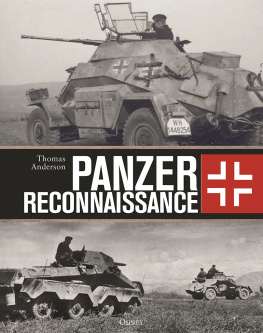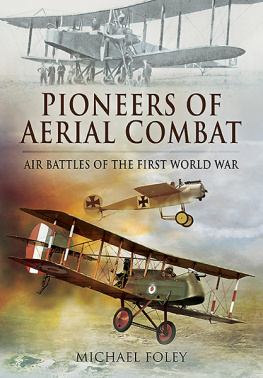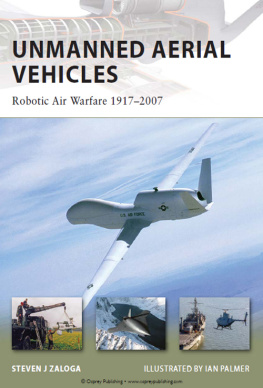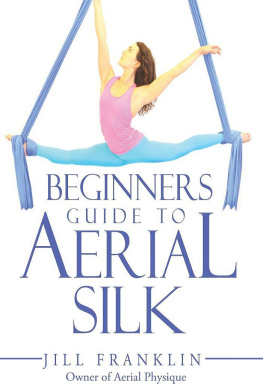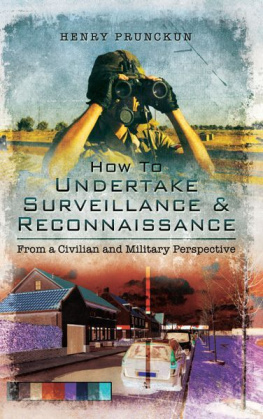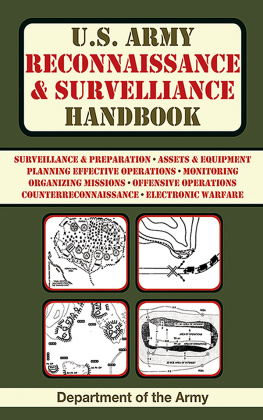Published in Great Britain and the United States of America in 2016 by
CASEMATE PUBLISHERS
10 Hythe Bridge Street, Oxford OX1 2EW, UK
and
1950 Lawrence Road, Havertown, PA 19083, USA
James Streckfuss 2016
Hardcover Edition: ISBN 978-1-61200-367-2
Digital Edition: ISBN 978-1-61200-368-9 (epub)
A CIP record for this book is available from the British Library
All rights reserved. No part of this book may be reproduced or transmitted in any form or by any means, electronic or mechanical including photocopying, recording or by any information storage and retrieval system, without permission from the publisher in writing.
Printed in the United Kingdom by TJ International
For a complete list of Casemate titles, please contact:
CASEMATE PUBLISHERS (UK)
Telephone (01865) 241249
Fax (01865) 794449
Email:
www.casematepublishers.co.uk
CASEMATE PUBLISHERS (US)
Telephone (610) 853-9131
Fax (610) 853-9146
Email:
www.casematepublishing.com
In memory of Sharon Streckfuss, whose contributions to this project and to my life are beyond evaluation, and who left us all much too soon
Acknowledgements
One of the first lessons learned in writing history is that it is never a solo process. Everyone needs help along the way and I can testify to having had a great deal of valuable assistance from many people during the research and writing of this book. Of course the History Department faculty of the University of Cincinnati stand out for their close involvement in guiding the dissertation that provided the starting point, particularly Dr. Christopher Phillips, Dr. Willard Sunderland, and Dr. Martin Francis. Dr. John H. Morrow, Jr., of the University of Georgia, had been a valued friend and colleague for several years prior to the start of this project, and his work in this field continues to inspire countless researchers and writers. Several other UC historians, though not directly involved in the final product, nevertheless contributed through the examples they provided in demonstrating how this kind of work should be done. Dr. Daniel Beaver, with whom I was privileged to study during his last year at UC, Dr. Thomas Sakmyster, Dr. John K. Alexander, Dr. David Stradling, and Dr. Edward Ross Dickinson, now at the University of California, Davis, all made me a better student of history.
Outside the University of Cincinnati community many friends, most of whom I came to know through the old Cross and Cockade Society, or the current League of World War I Aviation Historians and Cross and Cockade International, loaned research material or provided other help along the way. Funding for my research junket to London to mine the vast holdings of the British National Archives Public Record Office and the Moore-Brabazon and Laws Collections at the Royal Air Force Museum came from the late Bruce and Ralph Hooper of the Elizabeth S. Hooper Foundation. This family foundation, named in honor of their mother, maintained a long and impressive record of supporting organizations that honor the service of men and women who have worn the uniform of this country and I am myself honored that they chose to support my efforts as well. Staff members of the National Archives Public Records Office perform their jobs in a highly professional manner, juggling the demands of several hundred curious researchers every day. Amidst the chaos they never failed to lend whatever assistance I needed. The same can be said of the staff at the Royal Air Force Museum, especially Peter Elliott, who arranged for a waiver of the rules so that I could bring a digital camera into the facility at a time before cameras were regularly allowed. During my stay in London, Michael and Shibohan Herne were extremely gracious hosts who made me feel more like family than a temporary boarder.
Colonel Terry Finnegan, USAF (Ret.), and Dr. Birger Stichelbaut both served as valuable sounding boards and people with similar views on the role and importance of aerial reconnaissance. Dr. Stichelbauts efforts in organizing the 2006 Images of Conflict: Military Aerial Photography and Archaeology conference in Ypres, Belgium, where we all had the chance to share ideas, were especially appreciated. The University of Ghents Department of Ancient History and Archaeology and the In Flanders Fields Museum also deserve thanks for their sponsorship of the conference. Steve Suddaby and Colonel Steve Ruffin, USAF (Ret.), provided many good suggestions and advice. Noel Shirley, who served for more than a decade as assistant managing editor of Over the Front, shared much primary source material without which there would have been little said here about naval aviation. The late Peter Grosz and the late Neal OConnor, both of whom still stand as giants in the field of First World War aviation research, taught the world most of what is known about German aerial operations in the Great War. What little they did not cover, my friend Peter Kilduff has done, and he was also generous with his help. Aaron Weaver, as always, was a great help when it came to photographs. Sydney Barth, a young talent, and soon to be a design student at UCs College of Design, Architecture, Art and Planning, graciously provided the maps.
Several years before beginning graduate school, I had the opportunity to spend a few days rummaging through the records at the US Air Force Historical Research Agency and the library at the Air War College during a visit to Maxwell Air Force Base funded by a grant provided by the USAF HRA. The documents copied during that visit were essential to the chapter on balloon operations. I have not had a formal opportunity to thank agency officials for that generosity until now and would like particularly to mention Dr. Robert Johnson, of the Archives Division. Annie Pinder, of the UK Parliamentary Archives, also proved helpful answering an email query in a timely manner.
The people at Casemate, particularly Clare Litt, who provided valuable editorial advice, and Katie Allen who designed the cover, were instrumental in turning the original manuscript into the finished product.
The largest measure of gratitude goes to my family. My late mother, Ruby Streckfuss, and my sister, Virginia Gutzwiller, both learned long ago the question what would you like for Christmas often led to very odd answers. In this case, several holiday seasons spent shopping at the US National Archives collecting a complete set of the Gorrell Report on microfilm, an acquisition that ultimately saved immeasurably in both travel time and expense. Finally, my late wife, Sharon, our son, Erich, and most recently, my fianc Lucy Ginther, all endured many disruptions in their lives over several years in support of this research. In addition, they all regularly lent their technical expertise when called upon, helping solve more than a few hardware and software problems. Erich also allowed me to conscript him for a couple days service as research assistant photographing records at the National Archives College Park, Maryland, facility, saving me another road trip. To everyone I express my thanks. Any and all mistakes are mine alone.
Those interested in reading more First World War aviation history should consider membership of two outstanding historical organizations: The League of World War I Aviation Historians, www.overthefront.com, and Cross & Cockade International, www.crossandcockade.com.


